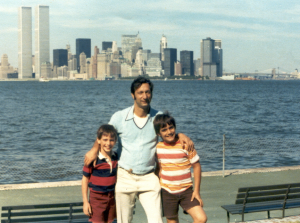No one who’s trying to get you to move to the suburbs tells you about the property taxes. Oh, it’s so great living out here in the suburbs! Look at the trees! Look at my big house! Look at my closet! Look at how my kid isn’t sleeping in that closet! ALL THIS SPACE!
And all that’s true. Pound for pound, living in the suburbs is a lot cheaper than living in the city. Food is cheaper. Clothes are cheaper. The dry cleaning is cheaper. In particular, the housing is cheaper – generally running about $300-$400 a square foot, when pricing in the city is more like $1,200 a square foot. So from a raw pricing perspective, housing in the suburbs is way cheaper than the city.
Except for the property taxes. Property taxes in the suburbs are MURDER. And the problem is that you don’t really pay attention to that when you’re looking for a new home in the suburbs. You’re looking at houses online, and all you see are these high-res pictures of giant houses with big lawns and actual foyeurs and humongous kitchens and OMIGOD LOOK AT THAT WALK IN CLOSET! And then you realize that for the same price as your tiny 1,000 square foot two bedroom in the city, you could get a 4,000 square foot colonial in some tony Westchester suburb. You figure out the down payment, you figure out your monthly mortgage payment, and you’re ready to go make an offer.
Not so fast. Check out the taxes. They’re on that listing somewhere, not all that prominent, buried deep in the fine print, and sometimes the real estate agent doesn’t even list them. So keep looking…..looking……and….
WHAT THE EFF! FIFTY EFFING THOUSAND DOLLARS IN TAXES!!!! CAN THAT BE RIGHT????
It’s right. Lucky you, if you’re looking to move to the New York City suburbs, you’re going to be paying the highest property taxes anywhere in the country. Indeed, the local suburbs make up like three of the top ten highest-taxed counties in the nation.
Here’s the weird thing about property taxes in the suburbs. It’s not that they’re so high, it’s that property taxes in the city are ridiculously cheap. I don’t actually know why, but it’s probably based on the density – there are so many people living vertically on every square plot of Manhattan soil that the property taxes don’t need to be high in order to fund what is, after all, a pretty expensive local government.
Put it this way – I used to live in a two-bedroom brownstone apartment on the upper west side, in a building that had four total apartments totaling probably about 6,000 total square feet of living space. All four apartments together are probably worth about $7 million today. And the taxes on the building? About $30,000. Now, I live in a condo, about 4,500 square feet, worth probably about $1 million in today’s market, and I’m paying that same $30,000 in taxes. It’s crazy.
In fact, I’d argue that housing prices in Manhattan are so ridiculously high precisely because the taxes are so low. Think of it this way. At today’s rates, you can borrow $100,000 for about $400 per month, or $4,800 per year. If we round that up to $5,000, you can figure that for every $5,000 in taxes, you lose about $100,000 in property value. So if you have a Manhattan apartment that costs $1.5 million, and has $25,000 in yearly property taxes, and on the other side you have a Westchester home that costs $1,000,000, but has $50,000 in property taxes, the yearly cost of owning those homes is roughly comparable.
That said, before you decide that your kid is fine sleeping in a doggie bed in your hall closet, let’s remember a few things.
First, even with the property taxes, you still get a lot more space for the money. That apartment in the city costing $1.5 million? It’s got about 1,200 square feet. The house in the suburbs? More like 3,000 square feet. So you’re getting about three times the living space for the price.
Second, property taxes are deductible, so about a third of those taxes are coming back to you in tax savings. That evens the playing field a little.
Third, you have to THINK OF THE CHILDREN! Don’t forget that one of the reasons you’re probably moving to the suburbs is that you have kids, and you want them to go to good schools, and those good schools, with all the fancy computers and well-paid teachers and massive educational bureaucracy – all that costs money. So maybe if you have school-age kids you can take comfort in knowing that your property taxes are going toward their fancy Ivy-League baiting education.
That said, when you’re like me, and you don’t have kids in school yet, it does make you wonder. Like, can’t those little snots can get by with whatever text books they’ve been using all those year? I mean, seriously, have there been so many advances in the arts and sciences that ten- or twenty-year old textbooks aren’t good enough for these kids? What, has Nathanial Hawthorne come out with some new books recently?
Take history, for example. History hasn’t changed much, and you never get to modern history anyway. Ten year old history books are just fine. When I was a kid, we’d start American History every year with about a month on the explorers – “Ponce de Leon was looking for the fountain of youth” is among the useless facts that I can never forget. Then we’d idle along so that we’d get to the colonial era around November, so we could have a reenactment of the First Thanksgiving and wear funny hats. But if you spend three months on the explorers and Pilgrims, you end up compacting about 300 years of history into five months – by the end of the year, we’d be lucky to get to World War I, much less the modern era. To this day, I feel much more comfortable with my knowledge about Pocahontas then I do about Harry Truman. So I don’t see why these kids need new history books so long as the books they have get them through, say, the Korean War.
Of course, when my kids are old enough to go to school, it’s entirely possible I might be singing a different tune. WE NEED NEW MACS! That does sound like me.
Until that point, though, I’m going to continue hating that tax bill I get every year.
And so will you.

